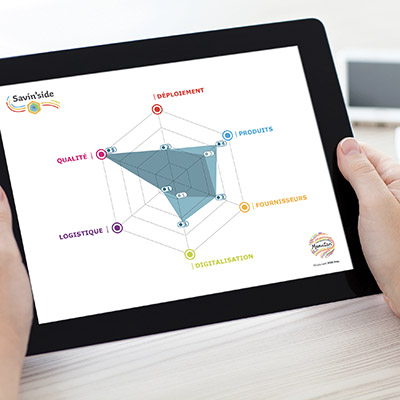In today's competitive and globalised environment, businesses are constantly seeking ways to optimise their supply chain and strengthen collaboration with partners. This is where EDI (Electronic Data Interchange) has gradually established itself within organisations. This tool enables the exchange of standardised electronic documents between two commercial partners, from computer to computer. It's not just a technological solution, but also a genuine lever for operational performance for businesses.
What is EDI?
EDI (Electronic Data Interchange) is a technology that allows businesses to exchange essential information securely and automatically. It replaces traditional channels such as postal mail, fax, or emails, eliminating the need for manual human intervention. This helps streamline and optimise information flows in terms of time, cost, and quality.
All commercial, logistical or financial documents can be digitised via EDI:
- Purchase orders;
- Buy orders;
- Mandates;
- Delivery notes;
- Invoices;
- Payments;
- Shipping notices;
- Customs declarations;
- Stock analyses...
In this sense, EDI is at the heart of the supply chain.
To use it, organisations must structure their data according to international technical reference standards. They must then be able to interpret and integrate this data into their own information system automatically.
Traditional data exchange vs EDI
The evolution of EDI
EDI has evolved considerably since its creation in the 1960s. Laurent Leboisne, Managing Director for France at Weexa[1], explains: "Gone are the proprietary tools and solutions specialised for a single sector of activity... International standards, such as Edifact, quickly came along to breathe a dose of interoperability beneficial to all companies. In the 2000s, asynchronous messaging protocols (Allegro, X400, GEIS...) were replaced by secure, encrypted and signed exchanges via the Internet. Then, in 2005-2010, XML standards made it possible to connect existing systems to Web and e-commerce platforms. And since 2015, APIs and Web services have enabled more real-time communication and enriched flows and processes."
From a tool reserved for large organisations, EDI has become a mature technology used by companies of all sizes and across all sectors. According to EDIBasics, more than 85% of electronic commercial transactions are now done via EDI. Today, the rise of Artificial Intelligence (AI) and Machine Learning (ML) is paving the way for even more intelligent and efficient communication between trading partners.
How does EDI work?
To enable information exchange, data must be structured in a standard format. This is the essential condition for computers to be able to process flows automatically.
Several standards exist (EDIFACT, XML, OCI...), each with multiple versions. Before sending any documents, trading partners must agree on the format (standard and version) they wish to use.
After that, the process works in four main stages.
1. Preparing documents
First, it's necessary to collect and organise the information needed to create the document.
2. Translating documents to the right format
Next, the internal document must be converted to the correct EDI format. For this, it's possible to purchase and use your own EDI translation software or go through a service provider.
3. Connecting and transmit documents
The documents are now ready! To send them to a trading partner, the company can use various methods:
- Direct connection using a secure protocol, also called "point-to-point";
- Connection via a value-added network (VAN) or an EDI network service provider.
4. Receiving documents
Once the data is sent, the process is reversed. The recipient validates the EDI message and, if there are no errors, proceeds with its transformation into a structured data file, which is then integrated into their information system.
|
Supplier’s company |

|
Customer’s company |
 The EDI sending process
The EDI sending process
|
EDI network service provider |

|
direct point-to-point communications |

|
communication software |

|
communication software |

|
EDI data |

|
EDI data |

|
EDI translator |

|
EDI translator |

|
Internal format data |
|
Internal format data |
The main benefits of EDI
EDI offers benefits for all stakeholders, suppliers and customers.
By digitising and optimising document exchanges, this technology boosts operational performance. These exchanges are then more fluid and faster, less expensive, and contain fewer errors.
Reducing costs
With exchanges now automated, processing costs, particularly those related to labour, decrease considerably. For example, the average cost of manual invoice processing is estimated at nearly €26.7/invoice (around £22.9/invoice) compared to about €3.10/ invoice (around £2.6/invoice) for electronic processing[2].
Increasing efficiency
The automation and digitalisation of exchanges significantly reduce human interventions. This helps decrease errors and optimise processing speed, while improving traceability and securing exchanges. The average processing time would drop from 5 days for paper transactions to less than an hour for EDI transactions[3].
Improving commercial relationships
Fewer errors and delays, adoption of a common language, faster communication, reduced costs... all these factors converge towards strengthening relationships between current or future trading partners.
Today, EDI stands as an effective solution supporting companies' digital transformation. Adopting it means equipping yourself with a strategic asset to improve your performance and competitiveness.
[1] Laurent Leboisne, Managing Director for France at Weexa, Comment l'EDI s'est imposé comme colonne vertébrale de la transformation digitale, 28 october 2020, le Journal du Net [https://www.journaldunet.com/solutions/dsi/1494889-comment-l-edi-s-est-impose-comme-colonne-vertebrale-de-la-transformation-digitale/]
[2] Forrester Consulting
[3] EDI pour Tous
[4] Stéphanie Bégard (Hospital pharmacist, PUI manager, Axium Clinique), L’EDI, FACILITÉ ET SIMPLICITÉ AVANT TOUT, Helpevia [https://www.helpevia.fr/actualites/ledi-facilite-et-simplicite-avant-tout.html]









